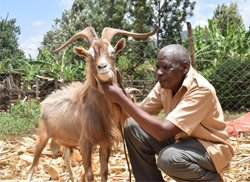
Shrinking lands, scarce pasture, unpredictable weather conditions and consumer appreciation of milk from other animals besides the cow have elevated the goat to a new pedestal of importance. According to the Dairy Goat Association of Kenya (DGAK), the future of goat-keeping in Kenya is already here.
The best breeds to keep for milk are Toggenburgs and German Alpines. Each animal offers up to three litres of milk a day. And with a litre of goat milk going for as much as Sh200, farmers are finding it a more sustainable and rewarding venture. DGAK is working to increase the number of German Alpine dairy goats to over a million across the country. Margaret Tanui, a farmer in Anin village in Kamogich location in Elgeyo Marakwet County, is a beneficiary.
The goats were introduced to the area by an NGO, Community Agricultural Development Project in Semi-Arid Lands (Cadsal), but Margaret and other farmers have pushed the project forward. She keeps seven German Alpines, four of which produce three litres of milk daily each. “They produce two litres in the morning and a litre in the evening, which is fed to the goat kids. In total, I get 12 litres daily from the four goats. We sell four litres and the remaining is used at home by the family,” she adds. A litre of goat milk in the area fetches Sh100 while that from a cow retails at Sh50.
“From our milk, we earn Sh400 daily, averaging Sh12,000 monthly. I can now afford most of our daily household needs without help from my husband,” she says. “I like the goats because they kid twice a year and if you are lucky and get all of them females, then you smile all the way to the bank,” another farmer Philip Kimutai says.
The 42-year-old has seven goats, three of which produce three litres of milk each daily. Kenneth Mbugua, a taxi driver, keeps goats at his home in Ruaka, on the outskirts of Nairobi. He said the animals are ideal because they require little space, feed less and their milk fetches premium prices.
I grow some napier grass on my land and buy some little more for the animals in caseI would need at least an acre to grow fodder
“Land is small in this county so I could not go for dairy cows. I started the project in 2008 with Sh50,000. Sh15,000 went to buying two animals.” Today, the farmer has 20 animals of the German Alpine, Toggenburg and Saanen breeds on his tiny land.
“I grow some napier grass on my land and buy some little more for the animals in case I exhaust mine. Supposing I was keeping a cow, I would need at least an acre to grow fodder,” he says. Besides napier grass, he feeds the animals potato peelings, hay and green maize peelings that he collects from markets. DGAK Technical manager Mwangi Warui says goat milk market is growing very fast, with companies seeking to sign contracts with farmers
“Buyers want a guaranteed amount of supply which farmers currently do not have the capacity to meet. Marketing is still a challenge as well,” he said. Inbreeding has also compromised quality and the association is promoting Artificial Insemination (AI) services, which were introduced in 2013.
With improved AI services, the association says, a farmer is guaranteed a minimum of four litres of milk per day per goat. Through the association, farmers who have no access to AI lease bucks to each other for as high as Sh3,000 per serving. On the other hand, a mature goat sells at between Sh15,000 and Sh35,000 depending on size and region.
DGAK initially had members in Nyeri, Murang’a, Kirinyaga and Embu counties, but expanded to Western and Nyanza regions. Expansion was informed by regional disparities in goat breeding and milk production. “While farmers in Western and Nyanza made huge profits from goat milk, those in Mt Kenya made more from specialised breeding. We realised that areas that were not in the initial plan were doing better than where the goats were first introduced. A good example is Nyanza and Western regions that produce the bulk of goat milk sold in Nairobi,” Warui says. The association has imported more than 70 bucks from Germany.
Tips for keeping dairy goats
